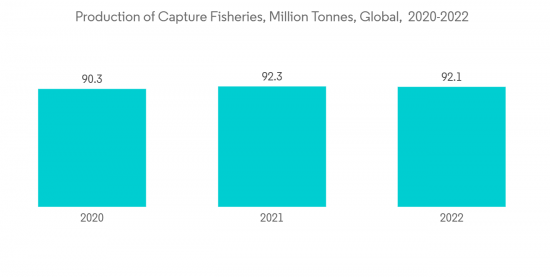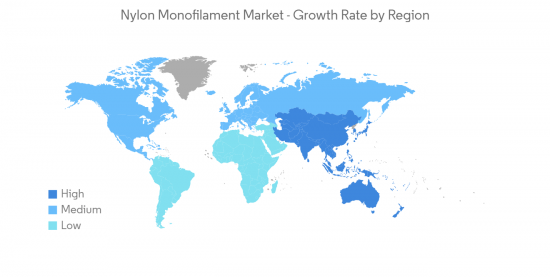
|
市場調査レポート
商品コード
1334427
ナイロンモノフィラメントの市場規模・シェア分析- 成長動向と予測(2023年~2028年)Nylon Monofilament Market Size & Share Analysis - Growth Trends & Forecasts (2023 - 2028) |
||||||
カスタマイズ可能
適宜更新あり
|
|||||||
| ナイロンモノフィラメントの市場規模・シェア分析- 成長動向と予測(2023年~2028年) |
|
出版日: 2023年08月08日
発行: Mordor Intelligence
ページ情報: 英文 120 Pages
納期: 2~3営業日
|
- 全表示
- 概要
- 目次
ナイロンモノフィラメント市場規模は、2023年の15億9,000万米ドルから2028年には20億8,000万米ドルに成長し、予測期間中(2023-2028年)のCAGRは5.50%と予測されています。
COVID-19パンデミックはナイロンモノフィラメント市場にマイナスの影響を与えました。ナイロンモノフィラメントは主に漁網の製造に使用されます。COVID-19の大流行は漁業・養殖業に悪影響を与えました。しかし、同市場は今後数年間はプラス成長を遂げると予想されます。
主なハイライト
- ナイロンモノフィラメント市場の成長を牽引する主な要因は、漁網用ナイロンモノフィラメントの需要拡大、自動車用途での採用急増、医療分野での新規用途です。
- しかし、ナイロンモノフィラメントの使用に関連する政府の規制や原料価格の変動が、ナイロンモノフィラメント市場の成長を妨げています。
- 産業用繊維用途の大幅な需要増加とバイオベースのナイロンモノフィラメントの開発は、推定・予測期間中に市場成長の様々な機会を提供すると思われます。
- アジア太平洋は世界のナイロンモノフィラメント市場において最大の地域です。また、中国、インド、日本などの国々からの消費の増加により、予測期間中に最も急成長する市場になると予想されます。
ナイロンモノフィラメント市場の動向
漁網セグメントからのナイロンモノフィラメント需要の増加
- ナイロン・モノフィラメントは合成繊維の一本鎖の連続フィラメントで、最も一般的に認識されているモノフィラメントはナイロン製釣り糸です。ナイロン・モノフィラメントはポリプロピレンよりも融点が高く、一般に260℃の範囲の温度で押し出されます。
- ナイロン・モノフィラメントは、費用対効果が高く、耐久性に優れているため、さまざまな漁網の生産に使用されています。漁業の拡大と魚の需要の増加は、今後数年間で漁網用途のナイロンモノフィラメントの需要を押し上げる可能性が高いです。
- 国連食糧農業機関によると、2030年までに水産動物の総生産量は約2億200万トンになると予測されています。さらに、廃棄物やロスの削減、資源管理の改善により、捕獲漁業は2020年から2030年にかけて6%成長し、9,600万トンに達すると予測されています。
- 国連食糧農業機関の年次食糧見通し(Biannual Food Outlook)によると、2022年の世界の養殖・漁業生産量は1.2%増の1億8,410万トンとなり、捕獲漁業は0.2%減、養殖漁業は2.6%増となります。2022年の捕獲漁業の世界生産量は9,210万トンと推定されています。
- アクアカルチャーマガジンによると、米国食糧農業機関の年2回の食料見通しによると、食生活の変化、都市化の進展、所得の急増により、2030年までに魚介類の1人当たりの平均消費量は21.4kgに達すると予測されています。水産物や捕獲漁業の生産と消費の増加は、漁網の需要をさらに押し上げています。
- したがって、ナイロンモノフィラメントの需要は、上記の要因により漁網用途で増加しています。

市場を独占するアジア太平洋地域
アジア太平洋地域は世界のナイロンモノフィラメント市場をリードしています。中国、日本、インドなどの国々で、漁網用ナイロンモノフィラメントの需要が高まり、自動車分野での用途が拡大していることが、この地域のナイロンモノフィラメント需要を牽引すると予想されます。
- アジア太平洋は魚類養殖の主要地域のひとつです。国連食糧農業機関によると、アジア太平洋の漁業・養殖業生産量は2030年までに9,400万トンに達すると推定されています。
- インド・ブランド・エクイティ財団は、インドは世界第3位の魚類生産国であり、世界第2位の養殖国であると述べています。2025年度の計画では、魚の輸出は57億2,000万米ドルから2025年までに122億8,000万米ドルに倍増すると予想されています。
- ナイロン・モノフィラメントは、ワイヤーハーネスやホースを引き裂きから保護するために自動車産業で広く使用されており、高い引張強度などの有益な特性を提供しています。優れた伸縮性と低吸湿性。
- 国際自動車工業会(OICA)によると、2022年の中国の自動車総生産台数は約2,700万台で、2021年と比較して販売台数は3%近く増加しました。このため、自動車生産台数の増加が同国のナイロンモノフィラメント市場を牽引するとみられます。
- 以上の要因から、アジア太平洋地域のナイロンモノフィラメント市場は予測期間中に大きく成長すると予測されます。

ナイロンモノフィラメント産業の概要
ナイロンモノフィラメント市場は部分的に統合されており、市場を独占しているのは少数の大手企業のみです。主な企業には、ABC Polymer Industries, LLC、Toray Industries Inc.、Superfil、AstenJohnson、Shakespeare Company, LLCなどがあります。
その他の特典
- エクセル形式の市場予測(ME)シート
- 3ヶ月間のアナリストサポート
目次
第1章 イントロダクション
- 調査の前提条件
- 調査範囲
第2章 調査手法
第3章 エグゼクティブサマリー
第4章 市場力学
- 促進要因
- 漁網におけるナイロンモノフィラメントの需要拡大
- 自動車用途での採用急増
- 医療分野での新規用途
- 抑制要因
- ナイロンモノフィラメントの使用に関連する政府の規制
- 原料価格の変動
- 産業バリューチェーン分析
- ポーターのファイブフォース分析
- 供給企業の交渉力
- 消費者の交渉力
- 新規参入業者の脅威
- 代替品の脅威
- 競合の程度
第5章 市場セグメンテーション(金額ベース市場規模)
- コポリマータイプ
- ナイロン6
- ナイロン66
- その他コポリマータイプ(ナイロン610、ナイロン612)
- 用途
- 漁網
- 医療用
- 自動車生地
- 消費財
- 編みロープ
- その他の用途(食品包装、スポーツウェア)
- 地域
- アジア太平洋
- 中国
- インド
- 日本
- 韓国
- その他アジア太平洋地域
- 北米
- 米国
- カナダ
- メキシコ
- 欧州
- ドイツ
- 英国
- フランス
- イタリア
- その他欧州
- 南米
- ブラジル
- アルゼンチン
- その他南米
- 中東・アフリカ
- サウジアラビア
- 南アフリカ
- その他中東とアフリカ
- アジア太平洋
第6章 競合情勢
- M&A、合弁事業、提携、協定
- 市場シェア(%)**/ランキング分析
- 主要企業の戦略
- 企業プロファイル
- ABC Polymer Industries, LLC
- AstenJohnson
- Atkins & Pearce
- ICF Mercantile LLC
- Nanjing Forever Textile Co.,LTD.
- RUICHANG MONOFILAMENT
- Shakespeare Company, LLC
- Shinkey Monofilament Enterprise Co., LTD.
- Superfil
- Toray Industries Inc.
第7章 市場機会と今後の動向
- 産業用テキスタイル用途の大幅な需要増
- バイオベースナイロンモノフィラメントの開発
The Nylon Monofilament Market size is expected to grow from USD 1.59 billion in 2023 to USD 2.08 billion by 2028, at a CAGR of 5.50% during the forecast period (2023-2028).
The COVID-19 pandemic negatively impacted the nylon monofilament market. Nylon monofilaments are mainly used in the manufacturing of fishing nets. The COVID-19 pandemic negatively impacted the fisheries and aquaculture sectors. However, the market is expected to achieve a positive growth rate over the coming years.
Key Highlights
- The major factors driving the growth of the nylon monofilament market are the growing demand for nylon monofilament in fishing nets, the surge in adoption in automotive applications, and novel applications in the medical sector.
- However, government restrictions related to the use of nylon monofilament and volatility in raw material prices are hindering the growth of the nylon monofilament market.
- Significant increases in demand from industrial textile applications and the development of bio-based nylon monofilament are estimated to offer various opportunities for market growth over the forecast period.
- Asia-Pacific represents the largest region in the global nylon monofilament market. It is also expected to be the fastest-growing market over the forecast period owing to the increasing consumption from countries such as China, India, and Japan.
Nylon Monofilament Market Trends
Growing Demand for Nylon Monofilaments from the Fishing Net Segment
- Nylon monofilament is a single, continuous-strand filament of synthetic fiber, and the most commonly recognized monofilament is a nylon fishing line. Nylon monofilaments have higher melting points than polypropylene and are generally extruded at temperatures in the range of 260 °C.
- Nylon monofilament is used to produce a variety of fishing nets owing to its cost-effective and durable properties. Expansion in the fishing industry and increasing demand for fish are likely to boost the demand for nylon monofilament for fishing net applications over the coming years.
- According to the Food and Agriculture Organization of the United Nations, by 2030, the total production of aquatic animals is projected to account for around 202 million metric tons. Moreover, owing to reduced waste and losses and improved resource management, the capture fisheries are projected to grow by 6% from 2020 to 2030 in order to reach 96 million metric tons.
- According to the Biannual Food Outlook of the Food and Agriculture Organization of the United Nations, in 2022, global aquaculture and fisheries production will have increased by 1.2% to 184.1 million metric tons, with capture fisheries decreasing by 0.2% and aquaculture increasing by 2.6%. The global production of capture fisheries was estimated at 92.1 million metric tons in 2022.
- The Aquaculture Magazine stated that, according to the Biannual Food Outlook of the Food and Agriculture Organization of the United Nations, the average per capita consumption of seafood is projected to reach 21.4 kg by 2030, owing to shifting dietary habits, growing urbanization, and a surge in income. The increase in the production and consumption of seafood and capture fisheries is further boosting the demand for fishing nets.
- Hence, the demand for nylon monofilament is increasing in fishing net applications due to the abovementioned factors.

Asia-Pacific Region to Dominate the Market
The Asia-Pacific region is the leader in the global nylon monofilament market. Nylon monofilament's rising demand for fishing nets and its growing applications in the automotive sector in countries like China, Japan, and India are expected to drive the demand for nylon monofilaments in this region.
- Asia-Pacific is one of the leading regions in fish farming. According to the Food and Agriculture Organization of the United Nations, fisheries and aquaculture production in the Asia Pacific is estimated to reach 94 million metric tons by 2030.
- The Indian Brand Equity Foundation stated that India is the third-largest producer of fish and the second-largest aquaculture nation in the world. As per the plan set for FY 2025, fish export is expected to double from USD 5.72 billion to USD 12.28 billion by 2025.
- Nylon monofilament is extensively used in the automotive industry in order to protect wire harnesses and hoses from tearing and offers beneficial properties such as high tensile strength. Superior elasticity and low moisture absorption.
- According to the International Organization of Motor Vehicle Manufacturers (OICA), the total vehicle production volume in China stood at around 27 million units in 2022, which was an increase of nearly 3% in terms of sales compared to 2021. Thus, an increase in vehicle production volume is likely to drive the market for nylon monofilament in the country.
- Owing to the abovementioned factors, the market for nylon monofilament in the Asia-Pacific region is projected to grow significantly during the forecast period.

Nylon Monofilament Industry Overview
The nylon monofilament market is partially consolidated in nature, with only a few major players dominating the market. Some of the major companies are ABC Polymer Industries, LLC, Toray Industries Inc., Superfil, AstenJohnson, and Shakespeare Company, LLC.
Additional Benefits:
- The market estimate (ME) sheet in Excel format
- 3 months of analyst support
TABLE OF CONTENTS
1 INTRODUCTION
- 1.1 Study Assumptions
- 1.2 Scope of the Study
2 RESEARCH METHODOLOGY
3 EXECUTIVE SUMMARY
4 MARKET DYNAMICS
- 4.1 Drivers
- 4.1.1 Growing Demand for Nylon Monofilament in Fishing Nets
- 4.1.2 Surge in Adoption in Automotive Applications
- 4.1.3 Novel Applications in the Medical Sector
- 4.2 Restraints
- 4.2.1 Government Restrictions Related to the Use of Nylon Monofilament
- 4.2.2 Volatility in Raw Material Prices
- 4.3 Industry Value Chain Analysis
- 4.4 Porter's Five Forces Analysis
- 4.4.1 Bargaining Power of Suppliers
- 4.4.2 Bargaining Power of Consumers
- 4.4.3 Threat of New Entrants
- 4.4.4 Threat of Substitute Products and Services
- 4.4.5 Degree of Competition
5 MARKET SEGMENTATION (Market Size in Value)
- 5.1 Co-polymer Type
- 5.1.1 Nylon 6
- 5.1.2 Nylon 66
- 5.1.3 Other Co-polymer Types (Nylon 610, Nylon 612)
- 5.2 Application
- 5.2.1 Fishing Net
- 5.2.2 Medical
- 5.2.3 Automobile Fabrics
- 5.2.4 Consumer Goods
- 5.2.5 Braided Ropes
- 5.2.6 Other Applications (Food Packaging, Sports Wear)
- 5.3 Geography
- 5.3.1 Asia-Pacific
- 5.3.1.1 China
- 5.3.1.2 India
- 5.3.1.3 Japan
- 5.3.1.4 South Korea
- 5.3.1.5 Rest of Asia-Pacific
- 5.3.2 North America
- 5.3.2.1 United States
- 5.3.2.2 Canada
- 5.3.2.3 Mexico
- 5.3.3 Europe
- 5.3.3.1 Germany
- 5.3.3.2 United Kingdom
- 5.3.3.3 France
- 5.3.3.4 Italy
- 5.3.3.5 Rest of Europe
- 5.3.4 South America
- 5.3.4.1 Brazil
- 5.3.4.2 Argentina
- 5.3.4.3 Rest of South America
- 5.3.5 Middle-East and Africa
- 5.3.5.1 Saudi Arabia
- 5.3.5.2 South Africa
- 5.3.5.3 Rest of Middle-East and Africa
- 5.3.1 Asia-Pacific
6 COMPETITIVE LANDSCAPE
- 6.1 Mergers and Acquisitions, Joint Ventures, Collaborations, and Agreements
- 6.2 Market Share (%)**/Ranking Analysis
- 6.3 Strategies Adopted by Leading Players
- 6.4 Company Profiles
- 6.4.1 ABC Polymer Industries, LLC
- 6.4.2 AstenJohnson
- 6.4.3 Atkins & Pearce
- 6.4.4 ICF Mercantile LLC
- 6.4.5 Nanjing Forever Textile Co.,LTD.
- 6.4.6 RUICHANG MONOFILAMENT
- 6.4.7 Shakespeare Company, LLC
- 6.4.8 Shinkey Monofilament Enterprise Co., LTD.
- 6.4.9 Superfil
- 6.4.10 Toray Industries Inc.
7 MARKET OPPORTUNITIES AND FUTURE TRENDS
- 7.1 Significant Increase in Demand from Industrial Textile Applications
- 7.2 Development of Bio-Based Nylon Monofilament


